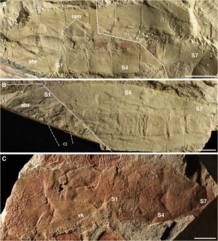
Fossils from the back of the Nesonektris aldridgei body. Diego Garcia-Bellido
EFE
is called Nesonektris aldridgei , and is a new species that has cataloged a team of scientists from the University of Adelaide (Australia). It is a invertebrate animal that inhabited the Earth about 515 million years and whose body does, between 10 and 15 centimeters in length, was divided into two parts.
The study, whose first author is Diego Garcia-Bellido Spanish, has been published in the open access journal BMC Evolutionary Biology and indicated that Nesonektris aldridgei and modern humans were “distantly related”.
The description of this being in strange ways was made from fossils found in South Australia . The first is found in the town of Emu Bay on Kangaroo Island, five years ago.
After analysis and discovery of more fossils, the scientists concluded that it was an animal of average size -until 15 inches long – with thick skin and the body divided into two parts: a anterior region and hinged rear tail
.
Anatomy of Nesonektris aldridgei
In the anterior region, this animal had a big mouth by going into the water , to filter and get the particles of food, as it does today-Ballena- shark, which then spewed by a lateral groove, the researcher explained García-Bellido.
In the back, researchers believe possessed a cartilaginous notochord inside helping you to swimming in the ocean . This is a cellular cord that is also present today in vertebrates before becoming spine.
“Today there is nothing exactly like it, but some relatives are similar, though smaller. salps, which have that previous large basket strainer and a tail that produces a stream of water, but float passively in actual seas “
Cataloging invertebrate
Nesonektris aldridgei has been included in the Vetulicolia class, which in turn is in the edge-commonly called cordados- Chordata, which also includes vertebrates and therefore our species. “We are not descended from them, but are distantly related”, said García-Bellido
Nesonektris means ‘ swimmer Island ‘ ( by Kangaroo Island and way of life) in Greek and the researchers chose ‘aldridgei’ in memory Dick Aldridge, British paleontologist and geologist University of Leicester.
García-Bellido, this work is important because, first, “ definitely ditch the discussion on the position of this group of animals -vetulicólidos- such strange appearance, which at some point was reached even consider that could be related to the arthropod-the group that includes crabs, spiders and beetles – “.
It came to relate to Nesonektris aldridgei with arthropods
Second: “It shows that chordates-the group that includes the vertebrates was a successful and diverse group from the beginning of animal evolution,” he concluded this scientist.
The Nesonektris in evolution
The Earth is 4,500 million years and the first 4,000 million existing life was unicellular, mainly bacteria.
Multicellular organisms did not appear until about 550 million years ago in what is known as ‘explosion’ of biodiversity in the Cambrian (first geological period Paleozoic), an evolutionary event that marked between 540 and 520 million years before the appearance of almost all groups of animals.
The signers of this study have these Cambrian fossils dated at about 515 million years .
No comments:
Post a Comment